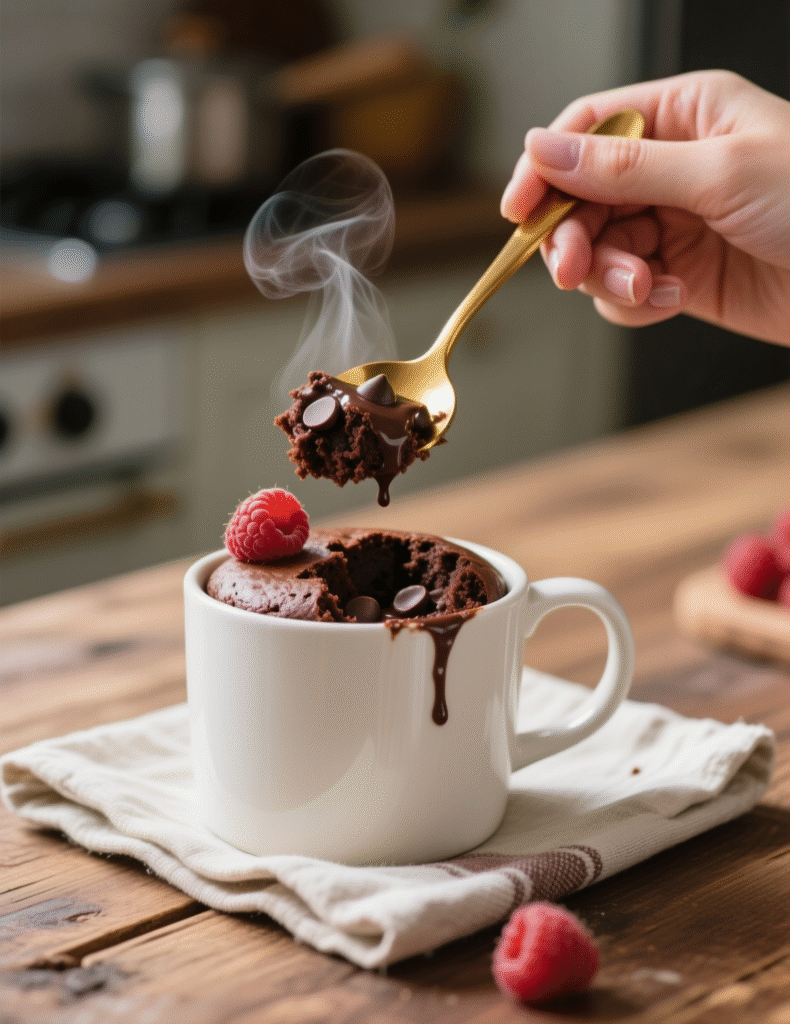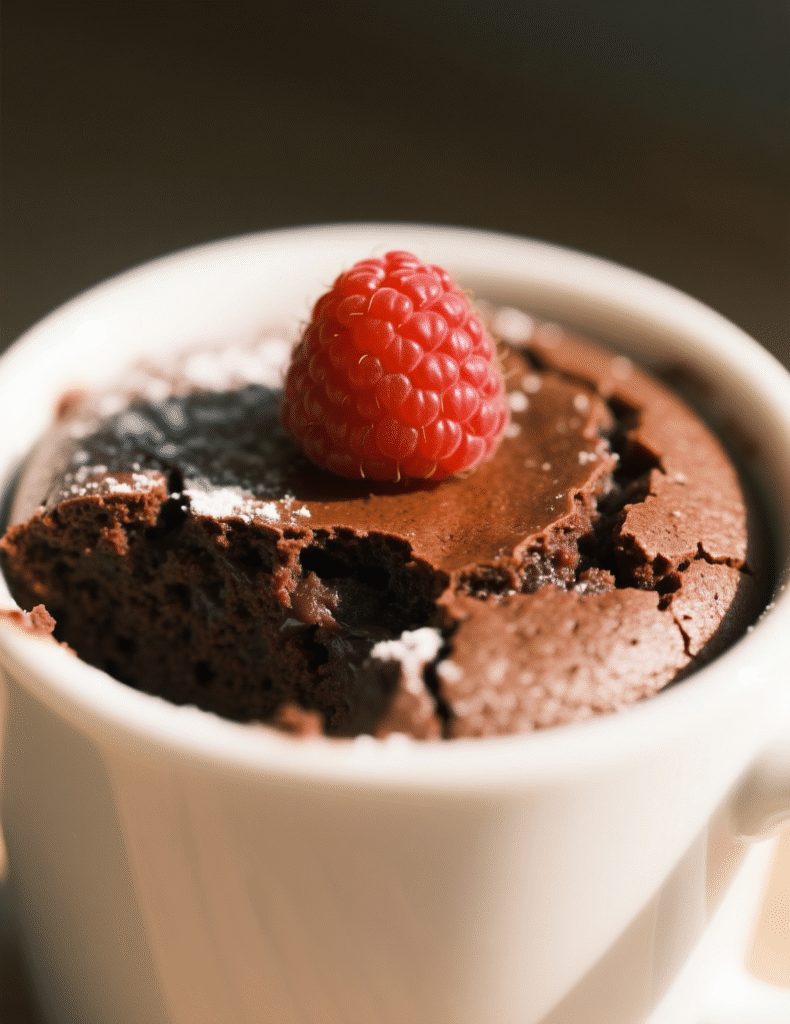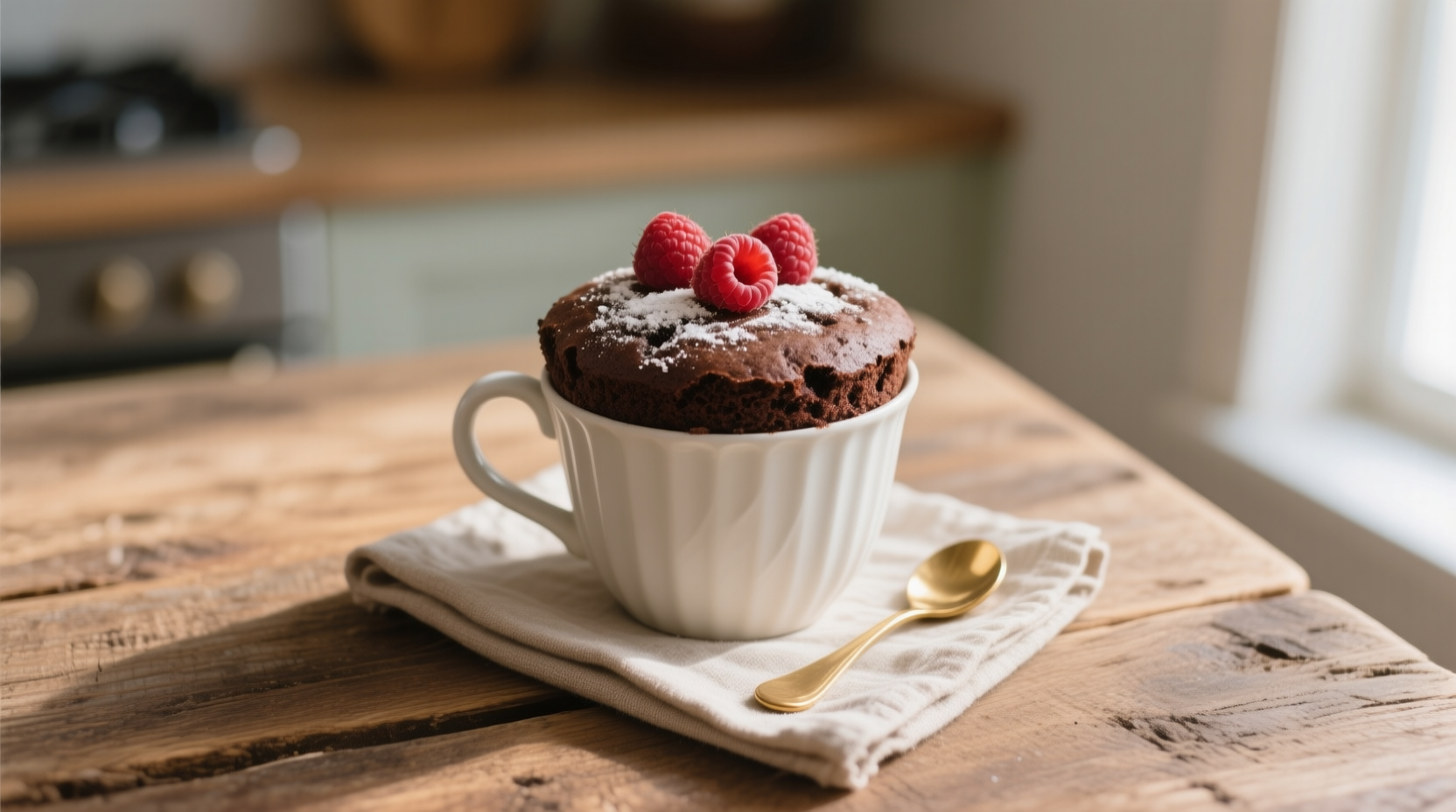There’s a certain magic in making cake in a mug. No mixing bowls sprawling across your counter, no oven preheating for what feels like eternity. You just whisk, microwave, and eat—before your tea gets cold. And when that cake happens to be vegan, rich, chocolatey, and ridiculously easy, well, you’ve got yourself a recipe worth bookmarking twice.
This isn’t your average “dump everything in a mug” situation. We’re going deep. Ratios matter. Ingredient behavior matters. Even microwaves—those innocent beige boxes—have quirks that will make or break your cake. I’ll show you not just how to make this easy vegan chocolate mug cake, but why it works so well. And maybe, just maybe, how to avoid the dense rubbery sponge that’s haunted more than a few mug cake dreams.
Why a Vegan Mug Cake Deserves Serious Attention
Most people think of mug cakes as quick sugar fixes. Fair. But a well-balanced vegan mug cake is a microcosm of baking science. It’s the ultimate test of ingredient substitution and cooking time precision. Without eggs or dairy, the structure, moisture, and flavor depend entirely on how you layer plant-based fats, sugars, and leavening agents.
Interestingly, a 2023 plant-based baking survey found that over 42% of home bakers attempted a vegan dessert at least once in the past year, with mug cakes ranking among the top three quick recipes tried. The draw is obvious—low commitment, high reward. You’re not baking a whole cake to experiment with oat milk ratios.
The science angle matters for professionals too. Mug cakes are essentially single-serve, rapid-prototype desserts. They allow for quick R&D in flavor balance, texture, and ingredient interplay—things you’d usually need hours of oven testing for.
The Foundation: Choosing the Right Flour
You could throw in whatever flour’s in the pantry, but if you want a cake with tender crumb and no gumminess, you’ve got to pick smart. All-purpose flour is the default for its moderate protein content—about 10–12%—which gives enough structure without turning tough.
Whole wheat flour? Too heavy here unless you cut it with white flour or sift it thoroughly. Almond flour? Deliciously nutty but needs a binder—often extra flax egg or a bit more oil—to prevent collapse.
Pro tip from the field: Sift your flour, even for a mug cake. Yes, it’s one mug, but lumps equal pockets of raw flour that won’t hydrate fully in 90 seconds. And trust me, biting into a flour knot is not an experience you’ll rave about.
Sweetness Beyond Just Sugar
Regular granulated sugar works fine, but if you want a deeper flavor, try coconut sugar. It lends a subtle caramel undertone that plays beautifully with cocoa. Brown sugar also works, and its molasses content adds moisture—important in microwave baking, where steam escapes faster than in an oven.
Avoid liquid sweeteners like maple syrup unless you adjust the flour and fat. Extra liquid will make the batter too loose, and in a microwave, that means it’ll boil over like a bad science experiment. Been there. Not fun cleaning chocolate glue off the turntable.
Cocoa Powder: The Flavor Driver
There’s no hiding in a small cake. Every gram of cocoa counts. Use natural cocoa for a sharper, old-school chocolate hit. If you want a rounder, smoother profile, Dutch-processed cocoa is the way to go. Professionals often blend the two—two-thirds Dutch, one-third natural—for a layered chocolate flavor.
And please, don’t skip blooming your cocoa. Just a teaspoon of hot water mixed in before adding the rest of your liquids wakes up the cocoa’s volatile compounds, giving you a fuller chocolate aroma. Yes, even in a 90-second cake.
Fat Choices: Why Oil Wins Here
In traditional cakes, butter offers flavor and aeration. But in a microwave, butter’s water content can steam your batter into a dense sponge. Oil, on the other hand, keeps the crumb soft without interfering with leavening.
Neutral oils like canola or sunflower work, but coconut oil pairs especially well with chocolate. If using coconut oil, make sure it’s melted and slightly cooled before mixing—pouring hot oil onto cold plant milk will seize it into sad little clumps.

The Plant Milk Decision
Oat milk brings creaminess. Almond milk is lighter but can lean watery unless you’re using a richer brand. Soy milk’s protein content actually helps bind and add body to the cake—probably the closest in behavior to dairy milk.
The key here is room temperature milk. Cold plant milk slows down the activation of baking powder, and in a mug cake, you don’t have time for it to “wake up” slowly.
The Leavening Magic
For this recipe, you’ll want baking powder, not baking soda alone. Baking soda needs an acid to activate, and while cocoa has some acidity, it’s not enough to give you that fluffy lift without risking a soapy aftertaste.
A pinch of salt rounds out the flavors, sharpens the chocolate, and keeps the sweetness from feeling flat. Don’t skip it. Even the tiniest granule matters in single-serve recipes.
The Method That Actually Works
- Dry First, Always – Combine flour, cocoa, sugar, baking powder, and salt right in the mug. This ensures even distribution before liquids join the party.
- Bloom Cocoa – Mix cocoa with a teaspoon of hot water before it meets the rest. This single step transforms the chocolate intensity.
- Add Wet Ingredients – Pour in your plant milk, oil, and optional vanilla extract. Stir until smooth but don’t overmix—you’ll overdevelop gluten and toughen the cake.
- Microwave Smart – Start with 70–80% power for 60 seconds, then check. Microwave wattages vary wildly. In my tests, 900-watt ovens needed 90 seconds, while 1200-watt ones were done in 75.
- Rest Before Eating – It’s tempting to dive in, but resting for 1–2 minutes lets the crumb set and prevents molten center burns.
Optional Enhancements
If you’re working professionally or just want to elevate things:
- Fold in a tablespoon of vegan chocolate chips. They create molten pockets.
- Swirl in a teaspoon of peanut butter before microwaving for a Reese’s-like effect.
- Sprinkle sea salt flakes on top after cooking for contrast.
Common Mug Cake Mistakes Professionals Still Make
- Overfilling the mug – Batter should be no more than halfway up the mug or it’ll overflow like lava.
- Ignoring microwave quirks – Some microwaves heat unevenly; rotate the mug halfway through if yours is guilty.
- Skipping the rest period – Structure sets as it cools; eating immediately often means gummy texture.
The Nutritional Angle
A single serving clocks in around 350–400 calories depending on sugar and oil choices. Swapping half the flour for almond flour boosts protein and adds healthy fats. Using unsweetened cocoa and coconut sugar lowers the glycemic load slightly.
Interestingly, a 2024 vegan dessert market report noted that single-serve vegan treats are driving growth in urban markets—linked to both portion control trends and the appeal of minimal-prep desserts.

Final Thoughts for Professionals
An easy vegan chocolate mug cake isn’t just a quick snack. It’s a compact laboratory of baking chemistry, portion control, and ingredient optimization. Professionals can use it to test flavor profiles in minutes rather than hours, while home cooks get an instant dessert without commitment.
The takeaways are simple but crucial:
- Ingredient temperature and ratios matter even in tiny recipes.
- Microwaves are not one-size-fits-all; learn yours like a friend with quirks.
- Cocoa blooming is the silent hero in small-scale chocolate baking.
Get this right, and you’ll never look at the “quick dessert” category the same way again. It’s proof that speed and quality can live in the same mug—if you know the rules to bend.
FAQs
Can I make this vegan chocolate mug cake gluten-free?
Yes, swap the all-purpose flour with a 1:1 gluten-free blend for best texture.
Which plant milk works best for this recipe?
Soy milk gives the best structure, but oat milk adds a creamier taste.
How long should I microwave the mug cake?
It usually takes 75–90 seconds, depending on your microwave wattage.
Can I use cocoa powder instead of Dutch-processed cocoa?
Yes, natural cocoa works, but Dutch cocoa gives a smoother chocolate flavor.
How do I prevent the mug cake from turning rubbery?
Don’t overmix the batter and avoid overcooking in the microwave.
Can I add mix-ins like nuts or chocolate chips?
Absolutely, but keep them small to avoid uneven cooking.
Why should cocoa powder be bloomed first?
Blooming releases deeper chocolate flavor and aroma instantly.
How far should I fill the mug with batter?
Only halfway to prevent overflow during microwaving.
Can I make it without oil?
Yes, replace oil with applesauce, but the texture will be less rich.
How long should I let the cake rest before eating?
One to two minutes helps the crumb set and prevents burns.

Mariana is a passionate home cook who creates delicious, easy-to-follow recipes for busy people. From energizing breakfasts to satisfying dinners and indulgent desserts, her dishes are designed to fuel both your body and hustle.
When she’s not in the kitchen, she’s exploring new flavors and dreaming up her next recipe to share with the Foodie Hustle community.

